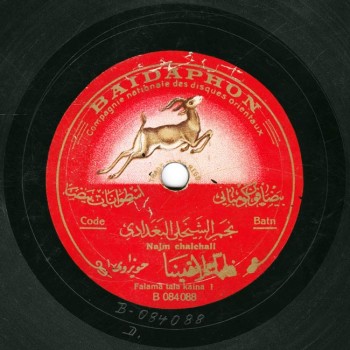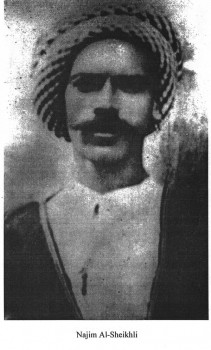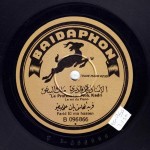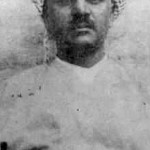 The Arab Music Archiving and Research foundation (AMAR), in collaboration with the Sharjah Art Foundation (SAF), presents “Min al-Tārīkh”.
The Arab Music Archiving and Research foundation (AMAR), in collaboration with the Sharjah Art Foundation (SAF), presents “Min al-Tārīkh”.
Dear listeners,
Welcome to a new episode of “Min al-Tārīkh”.
Today, we will be resuming our discussion about the disciples of al-ṭarīqa al-Zaydāniyya, i.e. the disciples of Aḥmad al-Zaydān, within our discussion on the history of the contemporary Iraqi maqām.
Before we continue our discussion with you Mr. Husayn, note that in our previous and future episodes, if we mention a muṭrib the foundation has no recordings of, we will only mention the historical information relative to him without broadcasting his recordings since we do not have them. Furthermore, since the source of some recordings is not AMAR, we may not have the necessary documentation on them: for example, in today’s episode, we will listen to a Najm al-Shaykhalī recording which we are sure was made in 1924 in the Levant, added to another recording I received through my friend Ṣāḥib ‘Abbās, whose original source is the great Iraqi maqām expert, musician and muṭrib Mr. Ḥāmid al-Sa‘dī, of Jamīl al-A‘ẓamī, and whose date and place of recording are unknown. I personally suspect it was recorded in Kuwait, but one can’t consider an assumption as a confirmed source.
Anyway… Let us talk about Najm.
Excuse me?
Najm.
Indeed, another “najm” (star) and a star indeed. Najm al-Shayakhlī (1893 – 1938) –who did not live long since he died at the age of 45– learned the style of his maqām performance from different sources. He was also, and mostly, a religious rites’ reciter.
His surname is affiliated to maḥallat “al-Shaykh” in reference to Sheikh ‘Abd al-Qādir al-Jīlānī, is it not?
Yes. All the surnames including “al-Shayakhlī” are affiliated to maḥallat “Bāb al-Shaykh” (i.e. Sheikh ‘Abd al-Qādir al-Jīlānī) in Baghdad. So he was also from this maḥalla. He nourished his maqām performance style from different sources, notably the ṭarīqa Zaydāniyya and Mullāh ‘Uthmān al-Mawṣilī who constituted a significant turn in religious rites, being the most ancient one added to the fact that he specialized in religious performance added to the many melodies he composed for religious pieces and tanzīl.
Two years before he passed away, he witnessed the birth of the Iraqi Radio whose official opening was announced in 1936, while it had started its experimental broadcasting in 1932. He witnessed this official opening and gave a number of concerts that were broadcasted live. Since there were no recording devices then, only broadcasting installations, many weekly concerts that were broadcasted live were never recorded and are lost forever. Najm al-Shayakhlī is among those who gave live concerts, and he has left us around twenty-one records of a collection of Iraqi maqām-s and songs made with the foreign record companies that arrived in Iraq in the 1920s. Their number is not as important as his significantly high performance level, yet note that no other Iraqi maqām performer kept this high level of performance that Najm al-Shayakhlī preserved throughout his twenty-one discs.
You mean that all his records are great.
They are all on the same high performance level, with an expressive content reflecting the past, present, and reality of his environment and illustrating clearly his aesthetic taste. Najm al-Shayakhlī’s exploitation of these performance experiments added to his knowledge of maqām-s shows clearly through all his maqām-s, notably the sikāh and the rāst –i.e. the main maqām that we talked about previously and that are “large” as a result of the numerous qiṭ‘a and waṣla that entered them. Muṭrib Najm al-Shayakhlī recorded the famous song with a religious character “A-lā yā min” that is, I think, by Mullāh ‘Uthmān al-Mawṣilī, within a beautiful disc…
It is truly very difficult to name a certain maqām recorded by Najm al-Shayakhlī as his best performance: on can’t say that any one of those is better than another as they are all on the same high level.
Still, let me mention the maqām manṣūrī to which he sang this copied qaṣīda and that I took from the site “Adab”. Here is the beginning:
“Mā fī al-ṣabābati manhalun musta‘dhabu illā wa-lī fī-hi al-aladhdhu al-aṭyabu”.
He also sang to the maqām rāst the following that was also interpreted by Umm Khulthūm:
“Kam ba‘athnā ma‘ al-nasīmi salāmā li-al-ḥabīb al-jamīl ḥaythu aqāma”.
And by Abū al-‘Ilā Muḥammad.
It is among the famous qaṣīda.
Najm al-Shayakhlī sang to the maqām ḥijāz:
“Hazzū al-qudūda fa-ikhjulū sumr al-qanā wa-taqalladū ‘iwaḍa al-suyūfi al-a‘unū”.
To the maqām sikāh, he sang:
Ashkū al-gharāma wa-anta ‘annī ghāfilun wa-yajiddu bī wajdī wa-ṭarfuka hazilu
Yā badru kam sahirat ‘alayka nawāẓirun yā ghuṣnu kam nāḥat ‘alayka balābilu
Al-badru yakmulu kulla shahrin marratan wa-hilālu wajhika kulla yawmin kāmilu
Beautiful!
To the maqām ‘ajam ‘ushayrān, he sang:
“Law-lā al-makhāfatu min ḍuba laḥaẓātihi la-janaytu wardan lāḥa min wajanātihi”
And another one to the maqām sikāh that I took from a site:
Khalīlayya dam‘u al-‘ayni qad jarraḥ al-khadda
Wa-bayyaḍa sha‘rī ba‘da mā kāna miswadda
Bulītu bi-qasī al-qalb ‘adhdhaba muhjatī
Raḍītu bi-hi mawlan
Wa-lam yarḍa bī ‘abda
La tada‘nī amūtu fī-ka ishtiyāqan
Fa-ittakhidhnī li-‘abdi ‘abdika ‘abda
I sang this song, not to a maqām, but to a form called poetry with ‘ubūdhiyya…
(♩)
The last artist we will talk about who was a disciple of the ṭarīqa Zaydāniyya is muṭrib Jamīl al-A‘ẓamī (1902 – 1967).
He is from my region “al-A‘ẓamiyya” in the centre of Baghdad. We do have information about the late muṭrib Jamīl al-A‘ẓamī… added to the information I brought as he was my neighbour and his family were our neighbours –I was young and he was my father’s age–, and as we were relatives –distant relatives–, and as I witnessed his last days… In fact, I heard him a few times and I can remember some situations where he used to joke around with me when I was still under 18, added to the fact that I received lately from his sister’s son the known Iraqi maqām critic Mr. Aḥmad Shākir Salmān al-A‘ẓamī information that is more precise and more credible than the information I had, since he was his nephew, and to the private e-mail I received from Baghdad through my brother Muḥammad on 8/7/2012 that tells about late muṭrib Jamīl al-A‘ẓamī added to the information provided in a previous letter from his first-born son who is knowledgeable in Iraqi maqām issues Mr. Aḥmad al-Sayyid Jamīl al-A‘ẓamī, besides the information provided by maqām muṭrib Fārūq al-A‘ẓamī who is our contemporary and still alive today. Fārūq is the son of Mr. Jamīl al-A‘ẓamī’s daughter… Jamīl al-A‘ẓamī was his grandfather.
I relied on all the information I received and on these sources to talk about muṭrib Jamīl al-A‘ẓamī who, according to all, was a disciple of the ṭarīqa Zaydāniyya in Iraqi maqām singing. I was surprised to learn from his son that Jamīl Bin Ismā‘īl Bin Ḥijāzī al-Ḥiyālī al-A‘ẓamī was born in al-A‘ẓamiyya in 1900, while most historians stated that he was born in 1902…
All these are problems linked to historical documentation.
Well I have to mention everything I know.
…in maḥallat “al-Safīna” located in al-A‘ẓamiyya in Baghdad. This is the first time Jamīl al-A‘ẓamī’s birth date is said to be 1900 while all the other sources state that he was born in 1902. In the second half of the 19th century (fifty or one hundred years before he was born), his father, grandfather, and uncles left Mawṣil and settled in al-A‘ẓamiyya where they established themselves as weavers of men’s garments, such as ‘abāya, and gauze made with wool threads spun with a jūma. He worked as a weaver all his life, while remaining passionate about Iraqi maqām and following and listening to the period’s maqām performers, mainly muṭrib and expert Qaddū al-Andulī –Qaddū al-Andulī Bin Muḥammad Āghā al-Qazzāz Bāshī who died in 1956– who was one of Jamīl al-A‘ẓamī’s teachers. He also learned the uṣūl of maqām from Rashīd al-Qundargī who was a disciple of the ṭarīqa Zaydāniyya… so we are still within the ṭarīqa Zaydāniyya. His voice steadied, and his ability to perform and to go deeper within the tunes evolved, and he started to rub shoulders with the celebrities who performed mawlid and religious tahlīla, mainly Mullāh Ḥāfiẓ Mahdī and Ḥāfiẓ Khammās and Ḥāj Rajab head of tahlīla in al-A‘ẓamiyya. Jamīl al-A‘ẓamī had learned to recite religious rites from a young age until he became an expert and specialized in them: he learned the uṣūl of tahlīla from Sayyid Jawād, i.e. the first head of tahlīla circles in Baghdad in the 1920s and 1930s, until he mastered them and became one of the major tahlīla reciters in Baghdad. After mastering religious rites’ reciting, including tahlīla, manqaba nabawiyya sharīfa, dhikr, …etc, he started learning mundane Iraqi maqām singing, and his first teacher was the known maqām muṭrib Qaddū al-Andulī (1873 – 1956) –mentioned earlier– a pupil of the great muṭrib Aḥmad al-Zaydān.
It was said that Jamīl al-A‘ẓamī also learned to sing Iraqi maqām from Ḥāj Jamīl al-Baghdadī –whose name was the first one on our list of ṭarīqa Zaydāniyya disciples, and whom we had introduced as the mu‘ammam (turbaned)– and from Rashīd al-Qundargī. Mr. Jamīl al-A‘ẓamī’s nephew Mr. Aḥmad Shākir Salmān denies this in his letter to me, naming Qaddū al-Andulī as his uncle’s only teacher.
Jamīl al-A‘ẓamī memorized many qaṣīda, in particular Sufi qaṣīda (In fact, we have not talked since the beginning of our episodes about Sufi poetry in Iraqi maqām singing, which will require a whole episode) chosen for him by late known historian and intellectual ‘Abd al-Jabbār Shawkat al-Najjār who chose the Sufi and non-Sufi qaṣīda that he deemed fit and rich enough in expression, meaning, and structure to be sung by the different Iraqi maqām singers and not only by Jamīl al-A‘ẓamī who recorded with his loud voice numerous maqām where he distinguished himself by his unique singing style that was different from that of all his peers and contributed to his fame and strengthened his presence on the maqām musical singing scene inside and outside Baghdad.
As soon as he became known for his beautiful voice and his mastery of the uṣūl of Iraqi maqām, he was invited in 1937 to sing at the Baghdad Radio where he interpreted more than twenty maqām-s, accompanied by the Radio’s musical jawqa or by the jālghī baghdādī ensemble, the first of which was the maqām khanabāt in Sufi poet Imām ‘Abd al-Raḥīm al-Bur‘ī’s famous qaṣīda:
“Fu’ādī bi-rab‘i al-zā‘inīna asīru yuqīmu ‘ala āthārihim wa-yasīru”.
Jamīl al-A‘ẓamī gave many concerts in the famous Baghdad homes and cafés, added to concerts in Kuwait in 1966 accompanied by the jālghī baghdādī ensemble including jawza player Sha‘ūbī Ibrāhīm and sanṭūr player Ḥāj Hāshim al-Rajab and a group of Iraqi artists. He recorded at the Kuwait Radio a collection of maqām-s including the maqām ṭāhir in this famous qaṣīda by al-Ḥājirī:
“ ‘Alimtum bi-annī mughramun bi-kum ṣabbu wa-dam‘ī saylan fawqa khaddī yanṣabbu”
The following is a cinquain qaṣīda that he sang to the maqām bayyāt.
Bada’tu bi-dhikri al-Lāhi madḥan muqaddaman
Wa-athnī bi-ḥamdi al-Lāhi shukran mu‘aẓẓaman
Wa-akhtumu qawl ī bi-al-ṣalāti wa-inna-mā
Uṣallī ṣalātan tamla’u al-arḍa w-al-samā
‘Ala man lahu a‘la al-‘ula mutabawwi’u
(♩)
Let us end our discussion about the ṭarīqa Zaydāniyya and its disciples.
We will meet again in a new episode of “Min al-Tārīkh”.
We thank Mr. Husayn al-A‘zami.
“Min al-Tārīkh” is brought to you by Mustafa Said.
- 221 – Zakariyya Ahmed – 12 (1/9/2022)
- 220 – Zakariyya Ahmed – 11 (1/9/2022)
- 219 – Zakariyya Ahmed – 10 (11/25/2021)
- 218 – Zakariyya Ahmed – 9 (10/26/2021)
- 217 – Zakariyya Ahmed – 8 (9/24/2021)
- 216 – Zakariyya Ahmed – 7 (9/4/2021)
- 215 – Zakariyya Ahmed – 6 (8/28/2021)
- 214 – Zakariyya Ahmed – 5 (8/6/2021)
- 213 – Zakariyya Ahmed – 4 (6/26/2021)
- 212 – Zakariyya Ahmed – 3 (5/27/2021)
- 211 – Zakariyya Ahmed – 2 (5/1/2021)
- 210 – Zakariyya Ahmed – 1 (4/28/2021)
- 209 – W-al-Lāhi lā astaṭī‘u ṣaddak 2 (4/6/2017)
- 208 – W-al-Lāhi lā astaṭī‘u ṣaddak 1 (3/30/2017)
- 207 – Bashraf qarah baṭāq 7 (3/23/2017)



